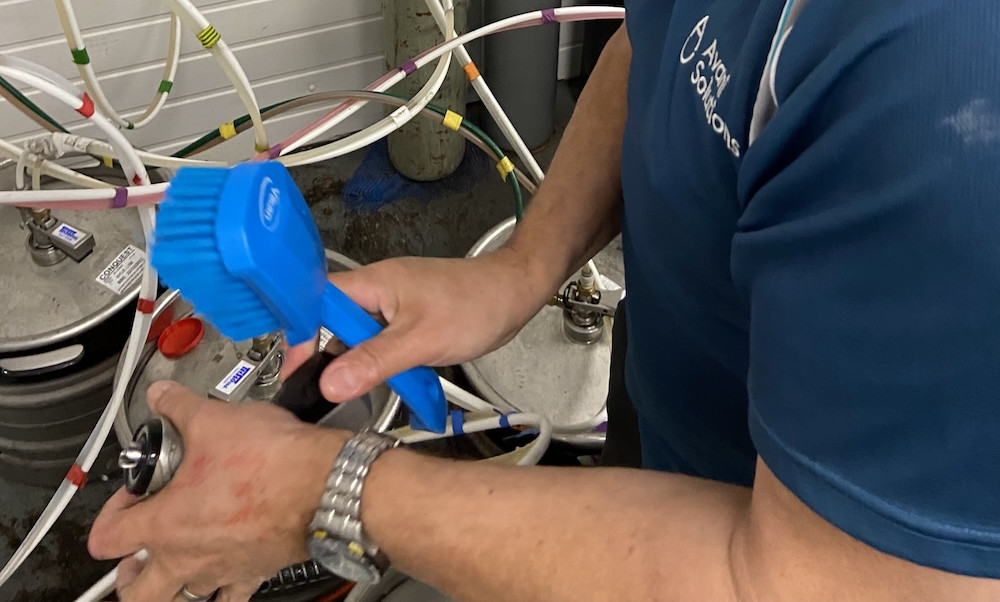Cellar cleaning: 11 Things that affect beer quality in the cellar (and how to fix them) + FREE checklist

“Have nothing in your pub’s cellar which you do not know to be useful or believe to be beautiful,” isn’t an entirely accurate quote from Victorian artist and designer William Morris.
He was talking about houses, but as pub and bar cellars are full of beautiful liquids like beer, it’s not a great stretch to imagine he’d have given the same advice to licensees.
Joking aside, the modern truth is that opportunities for cellar cleaning and to take stock of what’s happening in your cellar feel rare, but keeping on top of it can help prevent issues that could affect beer quality and efficient service.
So, here’s our checklist of recommendations to help you keep your cellar in order, and in turn improve beer quality and dispense.
1. Declutter
Remove anything from your cellar that is unrelated to beer or other drinks the dispense of which begins in the cellar. Arrange stock neatly and in date order with the soonest expiry dates at the front. Ensure out-of-date stock and empties are in an area from which they can easily be collected.
2. Audit equipment and label supplies
Make sure you have all the necessary cellar maintenance, drinks storage and service equipment. Store it in a well-organised way, using labelled shelves and/or storage tubs, so everything is quick and easy to find and you can see when supplies need to be replenished.
3. Record all faults
Make a note of any issues or faults that you can’t immediately remedy. Ideally create a fault list, so that anything needing attention is recorded in one place and can be dealt with as and when technical services are available.
Many of the suggestions included here also offer opportunities to troubleshoot and check everything is working as it should. In addition make a visual inspection of all couplers, fobs and cleaning sockets and make sure any broken and/or leaking parts are recorded.
4. Check your taps and hoses
Replace any broken taps and old, or inappropriate, hoses. For example, never make do with a garden hose! Use only food-grade materials to avoid unwanted taints and off-flavours in the drinks you serve.
5. Inspect drains and sumps
Check that cellar drains are clean and free running and clear them if they are blocked. If you have a sump, check the pump is working.
6. Check the condition of remote coolers
Wipe clean the unit’s external surfaces and the lagging. Ensure any grilles are free of dust and dirt and check coolant and water are topped up to appropriate levels.
If the water is cloudy, it will need to be cleared properly by your technical support service – as just emptying the water bath won’t stop bacteria and algae from returning.
Algae and bacteria aren’t just an ick factor, they’ll also make your cooler less efficient and might cause clogging of recirculation lines and pump.
As well as cleaning the exterior of the cooler, take a moment to check the top pump is working. If it isn’t, add it to your fault list.
7. Clean your cellar cooling vents and heat dumps
Switch off the cellar cooling and brush down the vents to remove dust and debris. If heat dumps can be safely accessed, check to ensure vents are clear.
Switch cellar cooling back on. If it’s not operating efficiently, such as not keeping things cool enough, add to your fault list.
8. Deep clean cleaning bottles
Cleaning bottles are a vital part of maintaining clean beer lines. Take a moment to inspect them and be sure to replace any that are damaged or likely to pass contamination onto your beer dispense system.
To clean the ones that are still in proper condition you need to wear the appropriate PPE to protect you from chemical detergent splashes.
Fill the bottle to a third with fresh water, mixed with approx 200ml of beer line cleaner. Agitate by using the cleaning spear to ensure the whole of the inside is cleaned entirely.
Then empty the bottle and thoroughly rinse it before leaving it to drain upside down. Store in the same, upside down, position so it remains dry.
9. Clean the floors and walls
It’s vital to keep on top of cleaning cellar floors and walls. Dust and dirt can lead to mould and if you have black mould this is a health hazard, that can also contaminate beer.
As well as washing walls and floors, make sure any mould is cleared using a solution of chlorine (eg. beer line cleaner that contains sodium hypochlorite) and consider treating the walls with an anti-fungal paint such as AMICAL to prevent regrowth.
10. Clean and maintain your backboard
Clean your backboard and ensure you remove any beer spatters. Repaint the board if necessary. Rewrite or replace the labels, making sure it’s clear which fob relates to which product.
11. Check cellar insulation
As a bare minimum make sure you’re able to keep cold air in and warm air out of your cellars. Ideally, also check the condition of all visible pipework to ensure lagging is providing adequate insulation.
We hope you’ve found our tips helpful. With a little planning and effort, you’ll have a beautifully clean and organised cellar and that can only be a good thing for your beer.
